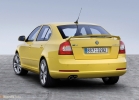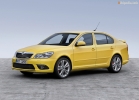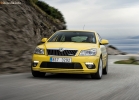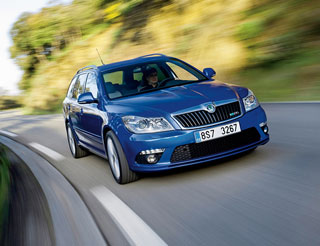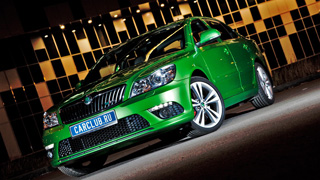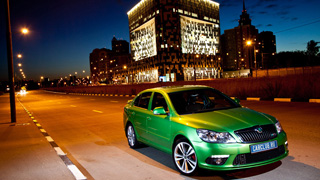Skoda Octavia RS Hatchback test drive since 2009 hatchback
Torture cold
Once caring motorists, protecting their iron horses, hid them in the garage for the winter. Now times have changed. Drivers operate cars year -round, and snowdrops have become exotic. Therefore, we begin a series of winter tests that will be held at the Dmitrovsky training ground. The pioneers were the hot hatchbacks of Mazda3 MPS, Skoda Octavia RS and Honda Civic Type-R.Honda Civic Type-R
Our winter is radically different about the one that is used to in other countries. In the middle strip, cold is stretched for six months. To find out how cars behave in the cold season, we begin a series of winter tests at the Dmitrovsky training ground.
Mazda3 MPS
Mazda3 MPS secretive racer. Understand that this treshka is more powerful than ordinary, you can only according to its rapidly retiring silhouette. Visually, almost nothing MPS does not distinguish or distinguish, although he has something to be proud of. The largest pride is a turbocharged engine with a volume of 2.3 liters and a capacity of 260 hp.
Skoda Octavia RS
Skoda Octavia RS is like a diligent student and son, who has absorbed all the best. In this case, these are brothers in the Volkswagen and Audi concern. And you need to admit, this is not bad. The result was a good family sports sedan, comfortable for everyone and fast for the driver. Each passenger can enjoy it.
Before starting tests, it is worth telling about the methodology of their implementation. As in the summer, two figures of double rearrangement and slalom remain the main ones. The speed of passing these figures is comparable to summer indicators with the only difference that the distances between the chips have changed. In the rearrangement, they are approximately doubled. The distance between the first gates is 21 m, and between the second 33 m. Another nuance: there is no fixed weekend of the gate in the winter stop. It is important here that the car will return to its so -called strip for 33 m. On slalom, the distance between cones increased from 18 to 36 m.
Significant changes have undergone the technique of spreading and acceleration measurements. Given the daily operation, urban conditions are simulated. We are talking about braking at a speed of 60 km/h and acceleration time in the first gear. In addition, the maximum speed is monitored in the same first gear. Tests are carried out on a flat surface, as well as on an 8 -percent rise.
Given the sports nature of the cars participating in the test, the sprint route was a separate test. It is conditionally divided into three sections: the first turns of different steepness, the second acceleration and inhibition on the heterogeneous coating (rolled snow and ice), the third turn during emergency braking. The total length of the track is 800 m.
All figures are performed with an activated stabilization system. But at first this is not about that. Firstly, it is worth paying attention to the steering wheel. It is in winter, when the connection of wheels with slippery roads cannot be called ideal, steering information is very important. In addition, all subjects are sporty in nature, so a progressive connection can be traced in all experimental with speed increasing the steering wheel noticeably heavy.
 Mazda3 MPS is distinguished by the most heavy steering wheel, which is associated with a rather heavy front. Still, a 2.5 -liner engine cannot be a fluff. The most sharp, even slightly nervous steering wheel is Honda Civic Type-R. Skoda Octavia RS turned out to be the more calm. At the same time, the connection with the road is not even lost at high speeds.
Mazda3 MPS is distinguished by the most heavy steering wheel, which is associated with a rather heavy front. Still, a 2.5 -liner engine cannot be a fluff. The most sharp, even slightly nervous steering wheel is Honda Civic Type-R. Skoda Octavia RS turned out to be the more calm. At the same time, the connection with the road is not even lost at high speeds. All exercises every car passes in its own way. The main criteria for the speed and clarity of overcoming a particular figure were the suspension settings and the operation of the stabilization system. In Mazda3, an excessive power of 260 hp is also mixed with these parameters. She does not always play on hand, which can be judged by the numbers of slalom. The trajectory of the detour of cones does not provide strong displacements of the car. This is due to the fact that the wheels slip. The stabilization system does not always manage to cope with the existing horsepower. As a result, the demolition of the front axis occurs. In this case, the automatically blocked differential does not have time to connect, since one of the front wheels is not unloaded. On Slalom, Mazda takes only second place.
But the power supply and the automatically blocked differential do their job in corners, for example, on rearrangements and on a sprint. Here Mazda is confidently leading. A hard suspension is not inclined to drift the rear axle. The wheel turned inside the rotation and differential help to maintain the right trajectory, dragging the car into a turn. The disadvantage of the dense Mazda suspension is short -term leature, which leads to breakdowns on irregularities. And this affects the wallet on the tires, hernias appear.
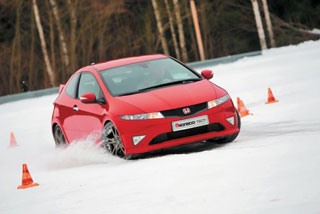 Honda Civic Type-R has the same short-term suspension. But it is very difficult to break through it due to high energy intensity. The result of such a settings was excessive nervousness on the road. You can control the machine only by grabbing the wheel tightly with both hands. Cutility, as well as all joints and irregularities, are felt by all the inhabitants of the Civic salon. You get tired of this, but on the other hand, you really feel like an athlete. You can forget about the rolls on Type-R. In Honda, the balance of weight and atmospheric engine power is excellent. But with the weight of the axes, not everything is okay. A larger percentage falls on the front axle. The result was an unloaded back beyond measure, and with the maximum squeezed, any error leads to a sharp breakdown of the front axle. It is very, very difficult to expose Civic, so it is better to go under the discharge of gas and with an intensive speed reduction. Ideal conditions for Type-R are high-speed winding areas, which can be judged by the passage of slalom and sprint. It is possible to develop maximum speed, maintaining the correct trajectory. At the same time, slipping is almost absent. As soon as the car begins the demolition of the front axle, very quickly and hard, as if someone was tucking a cable strongly, the stabilization system is triggered. She returns the car to the right path. For high speeds, this setting is perfect, but for the small, the system is almost completely trying to stop the car. This is confirmed by the numbers of the smallest output speed on a double stop.
Honda Civic Type-R has the same short-term suspension. But it is very difficult to break through it due to high energy intensity. The result of such a settings was excessive nervousness on the road. You can control the machine only by grabbing the wheel tightly with both hands. Cutility, as well as all joints and irregularities, are felt by all the inhabitants of the Civic salon. You get tired of this, but on the other hand, you really feel like an athlete. You can forget about the rolls on Type-R. In Honda, the balance of weight and atmospheric engine power is excellent. But with the weight of the axes, not everything is okay. A larger percentage falls on the front axle. The result was an unloaded back beyond measure, and with the maximum squeezed, any error leads to a sharp breakdown of the front axle. It is very, very difficult to expose Civic, so it is better to go under the discharge of gas and with an intensive speed reduction. Ideal conditions for Type-R are high-speed winding areas, which can be judged by the passage of slalom and sprint. It is possible to develop maximum speed, maintaining the correct trajectory. At the same time, slipping is almost absent. As soon as the car begins the demolition of the front axle, very quickly and hard, as if someone was tucking a cable strongly, the stabilization system is triggered. She returns the car to the right path. For high speeds, this setting is perfect, but for the small, the system is almost completely trying to stop the car. This is confirmed by the numbers of the smallest output speed on a double stop.  Skoda Octavia RS differs from opponents, primarily, body shape. This hatchback is more like a sedan. But the mass of the car is no more than that of the mPS treshka. The lavings on the axes, unlike both competitors, is close to the ideal one and is 60 to 40. When passing the tests, the Czech was heavier than everyone, because under the hood the smallest motor. We are talking about a turbocharged two -liter engine of 200 hp. Yes, and the rubber got non -navigable.
Skoda Octavia RS differs from opponents, primarily, body shape. This hatchback is more like a sedan. But the mass of the car is no more than that of the mPS treshka. The lavings on the axes, unlike both competitors, is close to the ideal one and is 60 to 40. When passing the tests, the Czech was heavier than everyone, because under the hood the smallest motor. We are talking about a turbocharged two -liter engine of 200 hp. Yes, and the rubber got non -navigable. But at the same time, RS is not very behind competitors. The four -second loss on the track is due only to rubber, which plays a decisive role, especially during acceleration on the heterogeneous coating of the second section (Fig. 2). But in all other disciplines, Skoda showed very good results, largely thanks to a more comfortable suspension. But without rolls, it was not done here. The most clearly they appear in areas with a good coating, where there are at least some clutch properties. You have to pay for comfort, but the connection with the road and the information content of the steering is not lost, which is very important. Skoda is the most swivel of all three contestants. It is not difficult to start it into a controlled skid, which is allowed even by an activated stabilization system. As a result, we get an excellent indicator on slalom. While in constant dynamic skids, it is possible to quickly overcome the snake. But the correction of the drift requires maximum attention.
Power does not always play a decisive role. Suspension setting is very important, and in winter, the work of the stabilization system is also. It works in its own way on each car, so in any case it requires addiction. Disconnecting the system in all three cars did not improve time or speed. Rather, the speeds increased, but it ended with rapidly developing amplitudes of drift. As a result, speeds close to the passage of disciplines with activated systems became optimal modes of passing figures. But the probability of losing a car on a slippery road with disconnected electronics is much higher.
Our verdict
The result of the winter test was unexpected. We were not able to identify a clear leader. Everyone became a leader in their nomination. First of all, behavior on the snow road is different. Honda Civic Type-R Complete Sports Car. Her slogan: fast, tough, clearly. Mazda3 MPS is not distinguished by an aggressive appearance, but if anything, you will get your nose to anyone. However, even a super -fast stabilization system does not always cope with excessive power, so rationality in actions should always be present. Skoda Octavia RS manifests itself as a quick car with a comfortable suspension and pleasant control.
Author: Maxim Egorov
Photo: Sergey Krestov
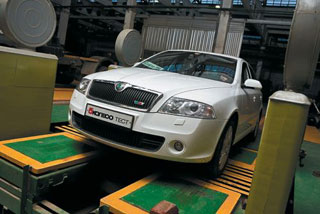


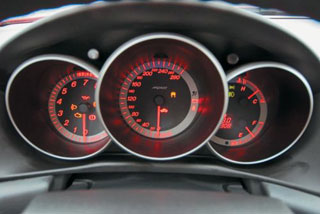

Source: Magazine 5 wheel [March 2008]


